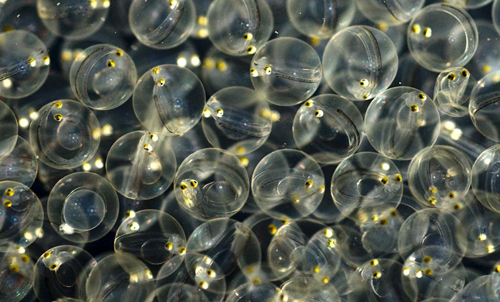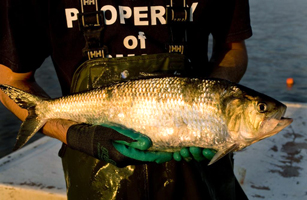Shad Project History
 American Shad,
Alosa sapidissima and
Hickory Shad
Alosa mediocris were two of the most important commercial and recreational fish species in the Chesapeake Bay before suffering severe population declines by the 1970s. In response to these declines, Maryland closed the American shad fishery in 1980, and the Hickory shad fishery in 1981. Despite the fishing moratorium, these depleted populations showed no signs of recovery, highlighting the need for a more active approach.
American Shad,
Alosa sapidissima and
Hickory Shad
Alosa mediocris were two of the most important commercial and recreational fish species in the Chesapeake Bay before suffering severe population declines by the 1970s. In response to these declines, Maryland closed the American shad fishery in 1980, and the Hickory shad fishery in 1981. Despite the fishing moratorium, these depleted populations showed no signs of recovery, highlighting the need for a more active approach.
In 1994, Maryland Department of Natural Resources and several partners implemented a restorative hatchery program to reintroduce shad spawning runs to selected tributaries. Techniques used to spawn, raise, and stock these species have been refined over several decades to maximize the production of larval and juvenile shad stocked into target tributaries, and ensure greater survival rates in the wild.

Shad Restoration Today
Since 1999, Office of Conservation Investment (formerly Sport Fish Restoration; F-57-R) funds have been utilized to conduct a long-term effort with three objectives for the successful restoration of American and hickory shad in Chesapeake Bay tributaries. The Choptank River and Patapsco River are current targets for restoration. Each year, the Choptank River is stocked with hatchery-raised American shad, while the Patapsco is stocked with both American and hickory shad.
Project Objectives and Methods:
Producing and stocking cultured American shad and hickory shad into target rivers:
- American shad brood stock and hickory shad brood stock is collected annually and are spawned within the department’s
warm-water hatcheries.
- The eggs of both species are marked on specific days during the first week after hatching using Oxytetracycline (OTC).
- Most of these fish are stocked as larvae into target rivers, while a small fraction is raised in hatchery ponds before being stocked as juveniles to improve their survival rate in the wild.
- Separate OTC marks are used to distinguish groups of fish stocked as larvae and groups that are stocked as juveniles.
- As hatchery-produced adult spawning stocks increase, the wild component of the juvenile population should exhibit corresponding growth.
- Restoration goals will be met when natural reproduction overwhelms the contribution of hatchery-produced fish in the juvenile population.
Monitoring the abundance and mortality of larval and juvenile shad:
- Juvenile shad surveys occur each fall in the Choptank River and Patapsco River.
- The wild and hatchery juveniles captured provide data used to calculate wild abundance estimates, larval mortality rates, hatchery contribution, and stocking success.
Estimating the contribution of hatchery fish to the adult spawning population and monitoring the recovery of naturally produced stocks in each river:
- Adult shad population surveys occur in target rivers during spawning runs each spring.
- The shad collected during this survey provide information used to monitor the age composition, hatchery contribution, and other population dynamics of the recovering adult spawning stock.
Timeline of Alosine Restoration Events
